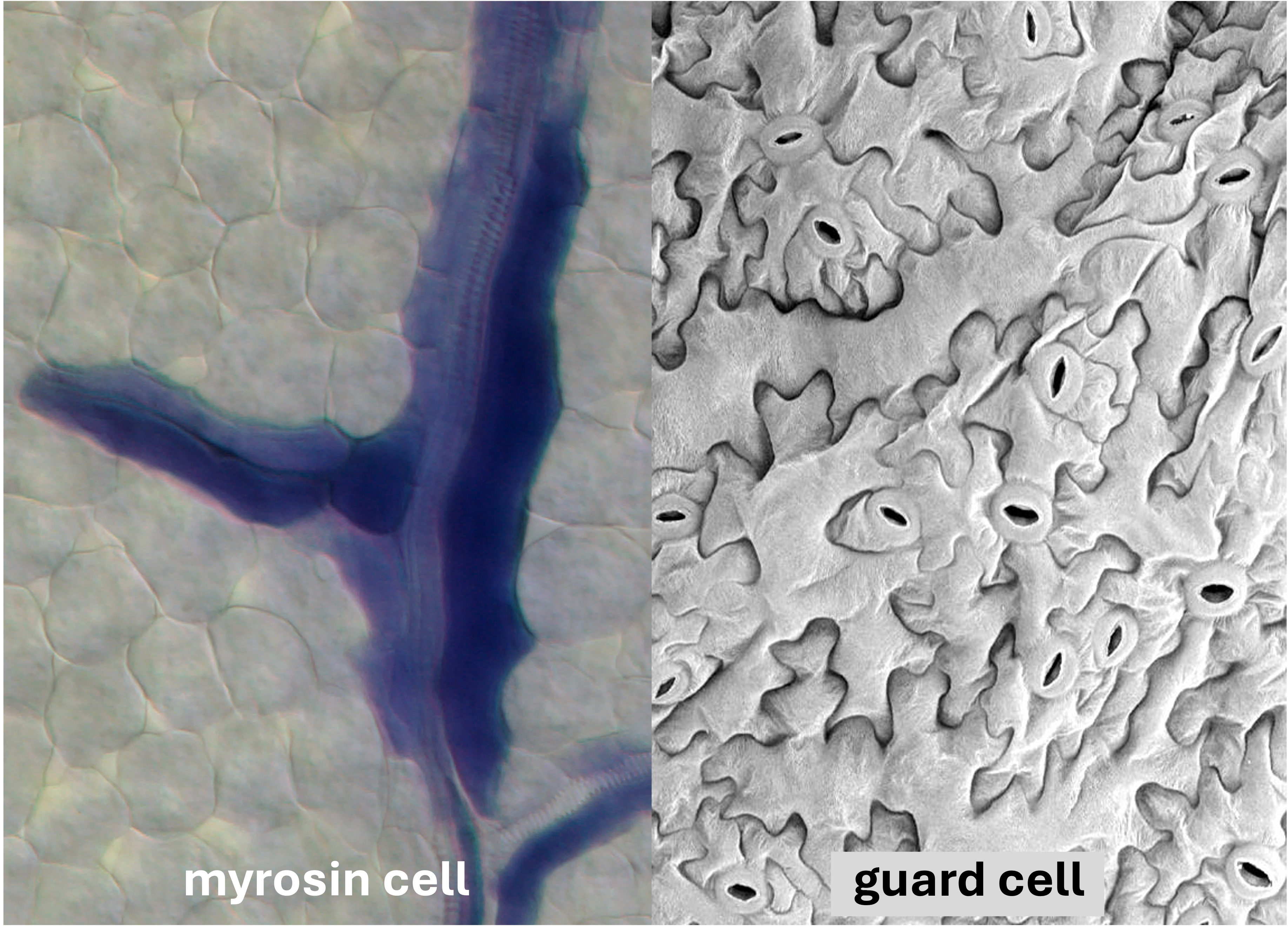
白川一 (Shirakawa, Makoto)
助研究員
- Plant development, specialized cells, transcription factor evolution
- makotos@gate.sinica.edu.tw
- makotos@as.edu.tw
- +886-2-2787-1114 (Office: A428/R509 (temporary Office))
- X:@MakotoShirakaw2
- ResearchGate
- Google Scholar
Shirakawa lab
Plant Idioblast Biology
Our vision is to establish “Plant Idioblast Biology” as a new field to advance understanding of plant cell diversity and adaptation.
Plants have evolved conserved and species-specific specialized cells to adapt to diverse environments. Idioblasts are specialized plant cells with distinct morphology and functions, often associated with unique metabolic or structural features. However, their developmental mechanisms and evolutionary trajectories remain largely unknown. One well-characterized example of a highly specialized cell is the guard cell, which adjusts stomatal aperture to regulate CO₂ uptake. Another example is the myrosin cell, a Brassicales-specific defense cell type, which has been a central focus of our research.

In previous work, we discovered that the transcriptional network, FAMA-WASABI MAKER (WSB)-Stomatal Carpenter 1 (SCAP1), was required for guard cell differentiation, while only FAMA-WSB was required for the differentiation of myrosin cells. These results suggest that FAMA-WSB were co-opted and neofunctionalized to generate species-specific idioblasts (Shirakawa et al., Nature Plants, 2025). Together, these findings highlight that the co-option and neofunctionalization of transcriptional networks play a pivotal role in the emergence of novel idioblasts during evolution.

Our laboratory was launched on September 1st, 2025, at the Institute of Plant and Microbial Biology, Academia Sinica, with the mission to uncover how plants rewire and evolve transcriptional networks to give rise to novel idioblasts that enable adaptation. Our vision is to establish “Plant Idioblast Biology” as a new field that advances our understanding of plant cell diversity and adaptation. By exploring a wide range of idioblast types, we will reveal the molecular mechanisms—such as gene co-option and neofunctionalization, including exon shuffling—that generate novel specialized cells. In doing so, we aim to illuminate the fundamental principles that create plant diversity and firmly establish Plant Idioblast Biology as a transformative new discipline.
Keywords: idioblast, cell differentiation, transcription factor, evolution, co-option, neofunctionalization
All publications
Selected Publications
Selected Publications (*equal contribution; †corresponding author)
【Original article】
- M. Shirakawa†, T. Oguro*, S.S. Sugano*, S. Yamaoka*, M. Sagara, M. Tanida, K. Sunuma, T. Iwami, T. Nakanishi, K. Horiuchi, K. Kumaishi, S. Yoshida, M. Watanabe, T. Tohge, T. Suzuki, Y. Ichihashi, A. Takemiya, N. Yamaguchi, T. Kohchi, T. Ito†, Co-option and neofunctionalization of stomatal executors for defense against herbivores in Brassicales, Nature Plants 11, 483–504 (2025).
- K.C. Moriya, M. Shirakawa, J. Loue-Manifel, Y. Matsuda, Y.-T. Lu, K. Tamura, Y. Oka, T. Matsushita, I. Hara-Nishimura, G. Ingram, R. Nishihama, J. Goodrich, T. Kohchi, T. Shimada†, Stomatal regulators are co-opted for seta development in the astomatous liverwort Marchantia polymorpha, Nature Plants 9, 302–314 (2023).
- T. Maeda, S.S. Sugano, M. Shirakawa, M. Sagara, T. Ito, S. Kondo, A.J. Nagano†, Single-cell RNA sequencing of inner tissues of Arabidopsis leaf identifies the rare cell types, myrosin and glucosinolate-producing cells, Plant and Cell Physiology 64, 234–247 (2023).
- M. Shirakawa, H. Ueda, T. Shimada, T. Kohchi, I. Hara-Nishimura†, Myrosin cell development is regulated by endocytosis machinery and PIN1 polarity in leaf primordia of Arabidopsis thaliana, Plant Cell 26, 4448–4461 (2014).
- M. Shirakawa, H. Ueda, A.J. Nagano, T. Shimada, T. Kohchi, I. Hara-Nishimura†, FAMA is an essential component for the differentiation of two distinct cell types, myrosin cells and guard cells, in Arabidopsis, Plant Cell 26, 4039–4052 (2014).
【Review article】
- M. Shirakawa†, M. Tanida, T. Ito†, The cell differentiation of idioblast myrosin cells: similarities with vascular and guard cells, Frontiers in Plant Science 12, 829541 (2022).
- M. Shirakawa†, I. Hara-Nishimura†, Specialized vacuoles of myrosin cells: chemical defense strategy in Brassicales plants, Plant and Cell Physiology 59, 1309–1316 (2018).
- M. Shirakawa, H. Ueda, T. Shimada, I. Hara-Nishimura†, FAMA: a molecular link between stomata and myrosin cells, Trends in Plant Science 21, 861–871 (2016).
國際
- 2026 年輕學者獎 - 日本植物生理學會